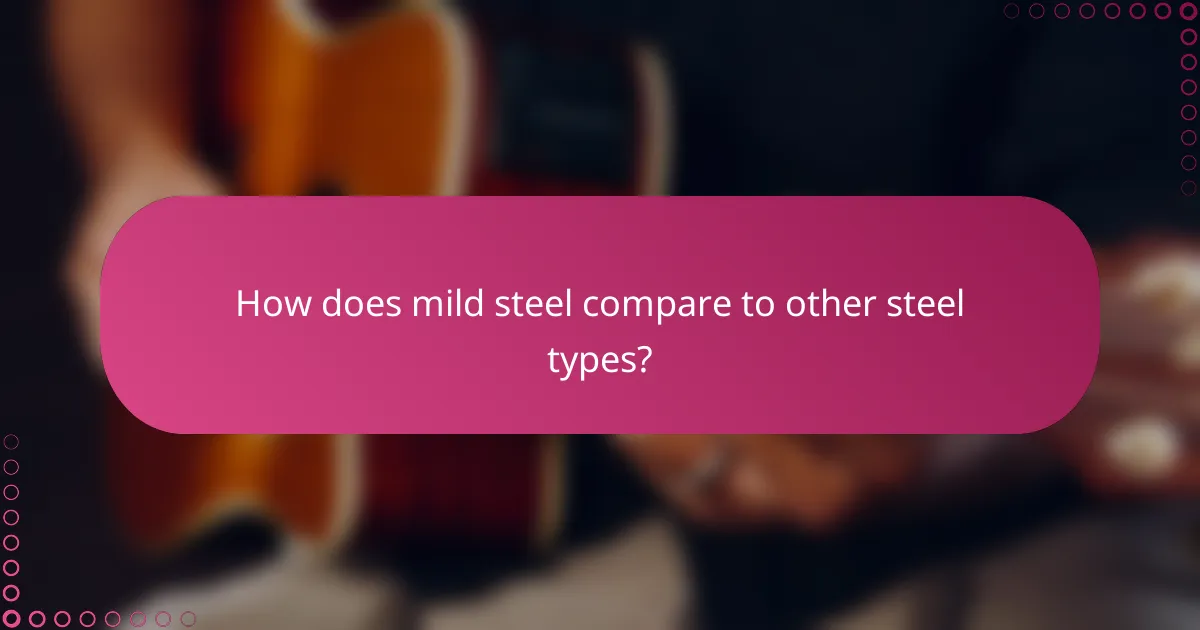Mild steel is a versatile material favored for its ease of workability, excellent weldability, and cost-effectiveness. These characteristics make it an ideal choice for a range of applications, including construction, automotive manufacturing, and fabrication. By understanding your specific project needs, you can effectively select the right type of mild steel to achieve optimal results.

How to choose mild steel for projects?
Choosing mild steel for projects involves understanding your specific needs, including the intended application, thickness, dimensions, and budget. By evaluating these factors, you can select the right type of mild steel that meets your requirements effectively.
Consider project requirements
Begin by identifying the specific requirements of your project. Consider factors such as load-bearing capacity, environmental conditions, and whether the steel will be exposed to corrosive elements. For example, if you’re constructing a framework for a building, you’ll need mild steel that can support significant weight.
Additionally, think about the fabrication processes involved, such as welding or machining. Mild steel is generally easy to work with, making it suitable for various applications, but certain projects may require specific grades or treatments.
Evaluate thickness and dimensions
The thickness and dimensions of mild steel are crucial for ensuring it meets your project’s structural needs. Common thicknesses range from a few millimeters to several centimeters, depending on the application. For instance, a thickness of 5-10 mm is often adequate for light structural work, while heavier applications may require 10 mm or more.
When selecting dimensions, consider the overall design and how the steel will fit within the project. Ensure that the dimensions align with standard sizes to avoid unnecessary waste and additional costs during fabrication.
Assess availability and cost
Availability and cost are essential factors when choosing mild steel. Prices can vary based on market conditions, location, and the specific type of mild steel. In general, mild steel is considered cost-effective, often priced in the low tens of USD per kilogram, but it’s wise to compare suppliers for the best deals.
Check local suppliers for availability, as some grades may be more accessible than others. Additionally, consider the lead time for delivery, especially if your project has tight deadlines. Planning ahead can help you avoid delays and unexpected costs.

What are the benefits of using mild steel?
Mild steel offers several advantages, making it a popular choice in various applications. Its ease of workability, excellent weldability, and cost-effectiveness contribute to its widespread use in construction, manufacturing, and fabrication.
Easy to work with
Mild steel is known for its malleability, which allows it to be easily shaped and formed into various structures. It can be cut, bent, and machined without requiring specialized tools, making it accessible for both professionals and DIY enthusiasts.
This material is often available in a range of thicknesses and forms, such as sheets, plates, and bars, providing flexibility for different projects. For example, a thickness of 1-10 mm is commonly used for general fabrication tasks.
Weldability advantages
The weldability of mild steel is one of its standout features, enabling strong and durable joints. It can be welded using various methods, including MIG, TIG, and stick welding, without the need for extensive pre-treatment.
When welding mild steel, it is advisable to use appropriate filler materials and maintain proper heat settings to avoid warping. This ensures that the welded joints maintain their integrity under stress, making mild steel suitable for structural applications.
Cost-effectiveness
Mild steel is generally more affordable than other types of steel and metals, making it a cost-effective option for many projects. Prices can vary based on market conditions, but it typically ranges from $0.50 to $2.00 per kilogram, depending on the form and thickness.
Its availability and ease of processing also contribute to lower labor costs, as less time and specialized equipment are required. This combination of low material costs and reduced labor expenses makes mild steel an attractive choice for budget-conscious projects.

What are common applications of mild steel?
Mild steel is widely used across various industries due to its ease of workability, weldability, and cost-effectiveness. Common applications include construction, automotive manufacturing, and fabrication, where its properties provide significant advantages.
Construction and structural applications
Mild steel is a fundamental material in construction and structural applications, often used for beams, columns, and frames. Its strength and ductility make it suitable for buildings, bridges, and other infrastructure projects. When selecting mild steel for construction, consider factors like load-bearing requirements and environmental conditions.
In many regions, mild steel is preferred for its cost-effectiveness compared to higher-grade steels. It is often available in various shapes, such as angles, channels, and plates, which can be easily fabricated on-site.
Automotive manufacturing
In automotive manufacturing, mild steel is commonly used for body panels, chassis, and structural components. Its weldability allows for efficient assembly processes, making it a staple in vehicle production. Manufacturers often choose mild steel for its balance of strength, weight, and cost, contributing to overall vehicle performance.
Automakers may apply coatings or treatments to enhance corrosion resistance, especially in regions with harsh weather conditions. This ensures the longevity of mild steel components in vehicles, which is crucial for safety and durability.
Fabrication and repair
Mild steel is favored in fabrication and repair due to its versatility and ease of manipulation. It can be cut, welded, and shaped using standard tools, making it accessible for both professional fabricators and DIY enthusiasts. Common applications include creating custom parts, machinery repairs, and artistic metalwork.
When working with mild steel, ensure proper safety measures are in place, such as wearing protective gear and using appropriate welding techniques. This will help avoid common pitfalls, such as warping or poor weld quality, which can compromise the integrity of the finished product.

How does mild steel compare to other steel types?
Mild steel is often favored for its workability, weldability, and cost-effectiveness compared to other steel types. While it offers good strength and ductility, its properties differ significantly from those of stainless and high-carbon steels.
Comparison with stainless steel
Mild steel is generally less corrosion-resistant than stainless steel, making it unsuitable for environments exposed to moisture or chemicals. Stainless steel contains chromium, which forms a protective layer against rust, while mild steel may require coatings or treatments for similar protection. However, mild steel is typically more affordable and easier to weld, making it a better choice for many construction and fabrication projects.
Comparison with high-carbon steel
High-carbon steel has a higher carbon content than mild steel, resulting in greater hardness and strength but reduced ductility. This makes high-carbon steel more suitable for cutting tools and wear-resistant applications. However, mild steel remains easier to work with and weld, making it ideal for general fabrication where flexibility and ease of use are priorities.

What are the welding techniques for mild steel?
Mild steel can be welded using several techniques, each with distinct advantages and considerations. The most common methods include MIG, TIG, and stick welding, which cater to different project requirements and skill levels.
MIG welding methods
MIG (Metal Inert Gas) welding is a popular choice for mild steel due to its speed and ease of use. This method uses a continuous wire feed as an electrode, which melts and fuses the metal pieces together while an inert gas shields the weld from contamination.
When using MIG welding, ensure proper settings for voltage and wire feed speed to achieve optimal penetration and bead appearance. It is suitable for both thin and thick materials, making it versatile for various applications.
TIG welding approaches
TIG (Tungsten Inert Gas) welding offers greater control and precision, making it ideal for thin sections of mild steel. This technique uses a non-consumable tungsten electrode to produce the weld, while a filler rod is manually added as needed.
For TIG welding, maintaining a steady hand and a consistent travel speed is crucial. This method is slower than MIG but produces cleaner and stronger welds, which is beneficial for critical applications where aesthetics and strength are paramount.
Stick welding processes
Stick welding, or SMAW (Shielded Metal Arc Welding), is a traditional method that is effective for outdoor projects and thicker materials. It uses a consumable electrode coated in flux, which generates a shielding gas when heated, protecting the weld pool from contamination.
This technique is less sensitive to wind and environmental conditions compared to MIG and TIG, making it suitable for construction and repair work. However, it can produce more slag and requires cleaning between passes, so proper preparation and technique are essential for quality results.

What are the specifications for mild steel?
Mild steel is characterized by its low carbon content, typically ranging from 0.05% to 0.25%. This composition makes it ductile, weldable, and cost-effective, suitable for a variety of applications from construction to manufacturing.
Common grades and standards
Mild steel is available in several grades, with the most common being ASTM A36, S235, and S275. These grades reflect different mechanical properties and yield strengths, making them suitable for various structural applications.
For instance, ASTM A36 is widely used in the United States for structural steel fabrication, while S235 and S275 are common in Europe. Understanding these grades helps in selecting the right material for specific projects, ensuring compliance with local building codes.
When choosing mild steel, consider factors like tensile strength, weldability, and corrosion resistance. Always refer to the relevant standards for your region to ensure the material meets the necessary specifications for safety and performance.

